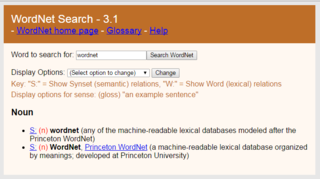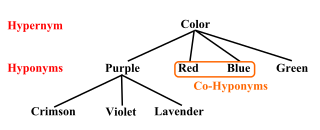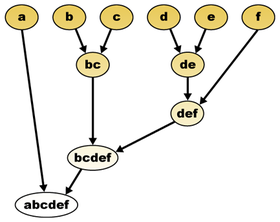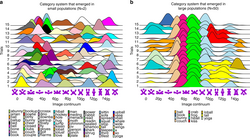
A semantic network, or frame network is a knowledge base that represents semantic relations between concepts in a network. This is often used as a form of knowledge representation. It is a directed or undirected graph consisting of vertices, which represent concepts, and edges, which represent semantic relations between concepts, mapping or connecting semantic fields. A semantic network may be instantiated as, for example, a graph database or a concept map. Typical standardized semantic networks are expressed as semantic triples.

WordNet is a lexical database of semantic relations between words that links words into semantic relations including synonyms, hyponyms, and meronyms. The synonyms are grouped into synsets with short definitions and usage examples. It can thus be seen as a combination and extension of a dictionary and thesaurus. While it is accessible to human users via a web browser, its primary use is in automatic text analysis and artificial intelligence applications. It was first created in the English language and the English WordNet database and software tools have been released under a BSD style license and are freely available for download from that WordNet website. There are now WordNets in more than 200 languages.

Hypernymy and hyponymy are the semantic relations between a generic term (hypernym) and a specific instance of it (hyponym). The hypernym is also called a supertype, umbrella term, or blanket term. The hyponym is a subtype of the hypernym. The semantic field of the hyponym is included within that of the hypernym. For example, pigeon, crow, and hen are all hyponyms of bird and animal; bird and animal are both hypernyms of pigeon, crow, and hen.
A faceted classification is a classification scheme used in organizing knowledge into a systematic order. A faceted classification uses semantic categories, either general or subject-specific, that are combined to create the full classification entry. Many library classification systems use a combination of a fixed, enumerative taxonomy of concepts with subordinate facets that further refine the topic.

In information systems, a tag is a keyword or term assigned to a piece of information. This kind of metadata helps describe an item and allows it to be found again by browsing or searching. Tags are generally chosen informally and personally by the item's creator or by its viewer, depending on the system, although they may also be chosen from a controlled vocabulary.
The Unified Medical Language System (UMLS) is a compendium of many controlled vocabularies in the biomedical sciences. It provides a mapping structure among these vocabularies and thus allows one to translate among the various terminology systems; it may also be viewed as a comprehensive thesaurus and ontology of biomedical concepts. UMLS further provides facilities for natural language processing. It is intended to be used mainly by developers of systems in medical informatics.

SNOMED CT or SNOMED Clinical Terms is a systematically organized computer-processable collection of medical terms providing codes, terms, synonyms and definitions used in clinical documentation and reporting. SNOMED CT is considered to be the most comprehensive, multilingual clinical healthcare terminology in the world. The primary purpose of SNOMED CT is to encode the meanings that are used in health information and to support the effective clinical recording of data with the aim of improving patient care. SNOMED CT provides the core general terminology for electronic health records. SNOMED CT comprehensive coverage includes: clinical findings, symptoms, diagnoses, procedures, body structures, organisms and other etiologies, substances, pharmaceuticals, devices and specimens.
In information science and ontology, a classification scheme is the product of arranging things into kinds of things (classes) or into groups of classes; this bears similarity to categorization, but with perhaps a more theoretical bent, as classification can be applied over a wide semantic spectrum.
Simple Knowledge Organization System (SKOS) is a W3C recommendation designed for representation of thesauri, classification schemes, taxonomies, subject-heading systems, or any other type of structured controlled vocabulary. SKOS is part of the Semantic Web family of standards built upon RDF and RDFS, and its main objective is to enable easy publication and use of such vocabularies as linked data.
Gellish is an ontology language for data storage and communication, designed and developed by Andries van Renssen since mid-1990s. It started out as an engineering modeling language but evolved into a universal and extendable conceptual data modeling language with general applications. Because it includes domain-specific terminology and definitions, it is also a semantic data modelling language and the Gellish modeling methodology is a member of the family of semantic modeling methodologies.
Frames are an artificial intelligence data structure used to divide knowledge into substructures by representing "stereotyped situations". They were proposed by Marvin Minsky in his 1974 article "A Framework for Representing Knowledge". Frames are the primary data structure used in artificial intelligence frame languages; they are stored as ontologies of sets.
Knowledge management software is a subset of content management software, which contains a range of software that specializes in the way information is collected, stored and/or accessed. The concept of knowledge management is based on a range of practices used by an individual, a business, or a large corporation to identify, create, represent and redistribute information for a range of purposes. Software that enables an information practice or range of practices at any part of the processes of information management can be deemed to be called information management software. A subset of information management software that emphasizes an approach to build knowledge out of information that is managed or contained is often called knowledge management software.
The concept of the Social Semantic Web subsumes developments in which social interactions on the Web lead to the creation of explicit and semantically rich knowledge representations. The Social Semantic Web can be seen as a Web of collective knowledge systems, which are able to provide useful information based on human contributions and which get better as more people participate. The Social Semantic Web combines technologies, strategies and methodologies from the Semantic Web, social software and the Web 2.0.
Ontology learning is the automatic or semi-automatic creation of ontologies, including extracting the corresponding domain's terms and the relationships between the concepts that these terms represent from a corpus of natural language text, and encoding them with an ontology language for easy retrieval. As building ontologies manually is extremely labor-intensive and time-consuming, there is great motivation to automate the process.
Enterprise bookmarking is a method for Web 2.0 users to tag, organize, store, and search bookmarks of both web pages on the Internet and data resources stored in a distributed database or fileserver. This is done collectively and collaboratively in a process by which users add tag (metadata) and knowledge tags.
Folksonomy is a classification system in which end users apply public tags to online items, typically to make those items easier for themselves or others to find later. Over time, this can give rise to a classification system based on those tags and how often they are applied or searched for, in contrast to a taxonomic classification designed by the owners of the content and specified when it is published. This practice is also known as collaborative tagging, social classification, social indexing, and social tagging. Folksonomy was originally "the result of personal free tagging of information [...] for one's own retrieval", but online sharing and interaction expanded it into collaborative forms. Social tagging is the application of tags in an open online environment where the tags of other users are available to others. Collaborative tagging is tagging performed by a group of users. This type of folksonomy is commonly used in cooperative and collaborative projects such as research, content repositories, and social bookmarking.
In natural language processing, semantic compression is a process of compacting a lexicon used to build a textual document by reducing language heterogeneity, while maintaining text semantics. As a result, the same ideas can be represented using a smaller set of words.
Classora is a knowledge base for the Internet oriented to data analysis. From a practical point of view, Classora is a digital repository that stores structured information and allows it to be displayed in multiple formats: analytically, graphically, geographically ; as well as carry out OLAP analysis. The information contained in Classora comes from public sources and is uploaded into the system through bots and ETL processes. The Knowledge Base has a commercial API for semantic enhancement, and an open web through which any user can access to part of the information collected.
The following outline is provided as an overview of and topical guide to natural-language processing:
Automatic taxonomy construction (ATC) is the use of software programs to generate taxonomical classifications from a body of texts called a corpus. ATC is a branch of natural language processing, which in turn is a branch of artificial intelligence.






